#XRISM
Text
Why Do X-Ray Mirrors Look So Unusual?
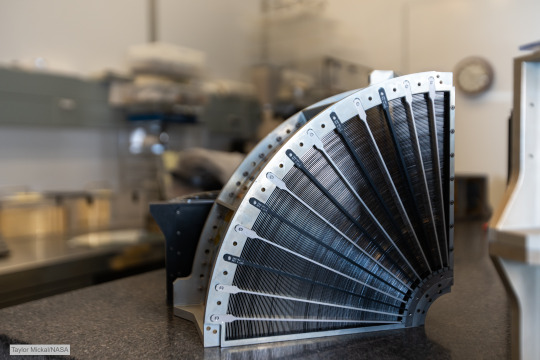
Does the object in this image look like a mirror? Maybe not, but that’s exactly what it is! To be more precise, it’s a set of mirrors that will be used on an X-ray telescope. But why does it look nothing like the mirrors you’re familiar with? To answer that, let’s first take a step back. Let’s talk telescopes.
How does a telescope work?
The basic function of a telescope is to gather and focus light to amplify the light’s source. Astronomers have used telescopes for centuries, and there are a few different designs. Today, most telescopes use curved mirrors that magnify and focus light from distant objects onto your eye, a camera, or some other instrument. The mirrors can be made from a variety of materials, including glass or metal.
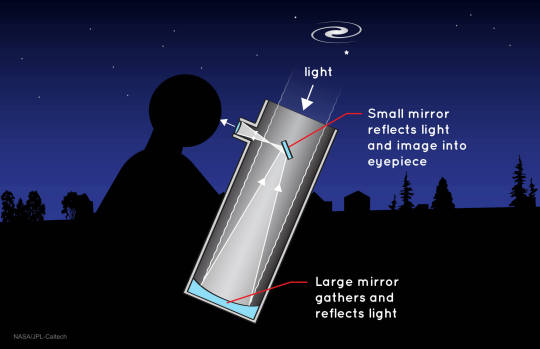
Space telescopes like the James Webb and Hubble Space Telescopes use large mirrors to focus light from some of the most distant objects in the sky. However, the mirrors must be tailored for the type and range of light the telescope is going to capture—and X-rays are especially hard to catch.
X-rays versus mirrors
X-rays tend to zip through most things. This is because X-rays have much smaller wavelengths than most other types of light. In fact, X-rays can be smaller than a single atom of almost every element. When an X-ray encounters some surfaces, it can pass right between the atoms!
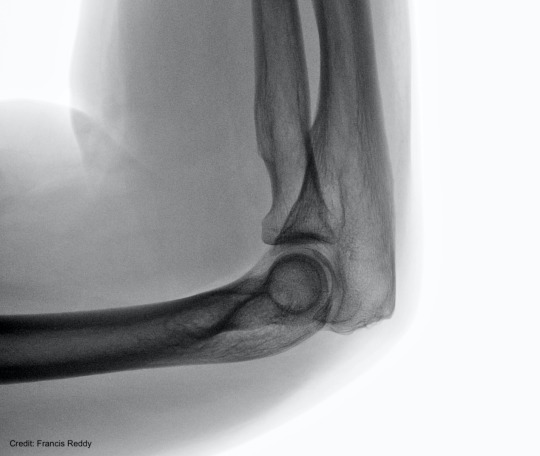
Doctors use this property of X-rays to take pictures of what’s inside you. They use a beam of X-rays that mostly passes through skin and muscle but is largely blocked by denser materials, like bone. The shadow of what was blocked shows up on the film.
This tendency to pass through things includes most mirrors. If you shoot a beam of X-rays into a standard telescope, most of the light would go right through or be absorbed. The X-rays wouldn’t be focused by the mirror, and we wouldn’t be able to study them.

X-rays can bounce off a specially designed mirror, one turned on its side so that the incoming X-rays arrive almost parallel to the surface and glance off it. At this shallow angle, the space between atoms in the mirror's surface shrinks so much that X-rays can't sneak through. The light bounces off the mirror like a stone skipping on water. This type of mirror is called a grazing incidence mirror.
A metallic onion
Telescope mirrors curve so that all of the incoming light comes to the same place. Mirrors for most telescopes are based on the same 3D shape — a paraboloid. You might remember the parabola from your math classes as the cup-shaped curve. A paraboloid is a 3D version of that, spinning it around the axis, a little like the nose cone of a rocket. This turns out to be a great shape for focusing light at a point.

Mirrors for visible and infrared light and dishes for radio light use the “cup” portion of that paraboloid. For X-ray astronomy, we cut it a little differently to use the wall. Same shape, different piece. The mirrors for visible, infrared, ultraviolet, and radio telescopes look like a gently-curving cup. The X-ray mirror looks like a cylinder with very slightly angled walls.
The image below shows how different the mirrors look. On the left is one of the Chandra X-ray Observatory’s cylindrical mirrors. On the right you can see the gently curved round primary mirror for the Stratospheric Observatory for Infrared Astronomy telescope.
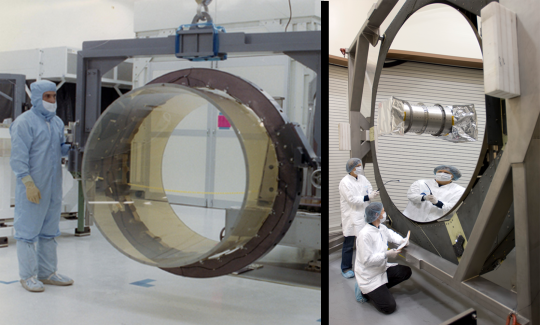
If we use just one grazing incidence mirror in an X-ray telescope, there would be a big hole, as shown above (left). We’d miss a lot of X-rays! Instead, our mirror makers fill in that cylinder with layers and layers of mirrors, like an onion. Then we can collect more of the X-rays that enter the telescope, giving us more light to study.

Nested mirrors like this have been used in many X-ray telescopes. Above is a close-up of the mirrors for an upcoming observatory called the X-ray Imaging and Spectroscopy Mission (XRISM, pronounced “crism”), which is a Japan Aerospace Exploration Agency (JAXA)-led international collaboration between JAXA, NASA, and the European Space Agency (ESA).
The XRISM mirror assembly uses thin, gold-coated mirrors to make them super reflective to X-rays. Each of the two assemblies has 1,624 of these layers packed in them. And each layer is so smooth that the roughest spots rise no more than one millionth of a millimeter.

Why go to all this trouble to collect this elusive light? X-rays are a great way to study the hottest and most energetic areas of the universe! For example, at the centers of certain galaxies, there are black holes that heat up gas, producing all kinds of light. The X-rays can show us light emitted by material just before it falls in.
Stay tuned to NASA Universe on Twitter and Facebook to keep up with the latest on XRISM and other X-ray observatories.
Make sure to follow us on Tumblr for your regular dose of space!
#NASA#spaceblr#astronomy#telescope#universe#astrophysics#XRISM#Chandra#x-ray vision#x-ray#space#technology#tech
1K notes
·
View notes
Text

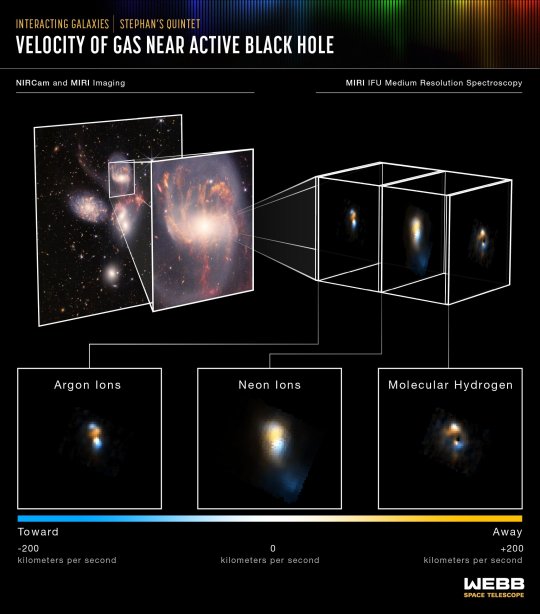
XRISM spacecraft will open new window on the X-ray cosmos
The upcoming XRISM (X-ray Imaging and Spectroscopy Mission, pronounced "crism") spacecraft will study the universe's hottest regions, largest structures, and objects with the strongest gravity.
Led by JAXA (Japan Aerospace Exploration Agency), XRISM will peer into these cosmic extremes using spectroscopy, the study of how light and matter interact. In this explainer, video producer Sophia Roberts from NASA's Goddard Space Flight Center walks us through how understanding spectroscopy deepens our knowledge of the universe.
"I think we all get excited for the beautiful images we get from missions like NASA's James Webb Space Telescope," Roberts said. "But after taking a deep dive into spectroscopy, I really appreciate the critical context it gives scientists about the story behind those pictures."
XRISM's microcalorimeter spectrometer, named Resolve, is a collaboration between JAXA and NASA. It will create spectra, measurements of light's intensity over a range of energies, for X-rays from 400 to 12,000 electron volts. (For comparison, visible light energies range from about 2 to 3 electron volts.)
To do this, Resolve measures tiny temperature changes created when an X-ray hits its 6-by-6-pixel detector. To measure that minuscule increase and determine the X-ray's energy, the detector needs to cool down to around minus 460° Fahrenheit (around minus 270° Celsius), just a fraction of a degree above absolute zero. The instrument reaches its operating temperature after a multistage mechanical cooling process inside a refrigerator-sized container of liquid helium.
Resolve will help astronomers learn more about the composition and motion of extremely hot gas within clusters of galaxies, near-light-speed particle jets powered by black holes in active galaxies, and other cosmic mysteries.
The Webb telescope captures similar spectra, but for infrared light. Webb's spectra have revealed the makeup of gas near active black holes and mapped the movement of this material toward or away from the viewer. Data from XRISM's Resolve instrument will do the same at higher energies, helping paint a fuller picture of these objects.
XRISM is a collaborative mission between JAXA and NASA, with participation by ESA (European Space Agency). NASA's contribution includes science participation from the Canadian Space Agency.
TOP IMAGE....This artist's concept shows a face-on view of the XRISM (X-ray Imaging and Spectroscopy Mission) spacecraft. Credit: NASA's Goddard Space Flight Center Conceptual Image Lab
LOWER IMAGE....Scientists studied NGC 7319, part of the visual grouping of galaxies called Stephan’s Quintet, using the Medium-Resolution Spectrometer (MRS) in the Mid-Infrared Instrument (MIRI) on NASA’s James Webb Space Telescope. The galaxy contains a supermassive black hole that is actively accreting material. The spectrometer features integral field units (IFUs) – each containing a camera and spectrograph. IFUs provided the Webb team with a collection of images of the galactic core’s spectral features, shown here. Blue-colored regions indicate movement toward the viewer and orange-colored regions represent movement away from the viewer. Powerful radiation and winds from the black hole ionize hot spots of super-heated gas, creating the argon and neon lines. The hydrogen line is from colder dense gas in the central regions of the galaxy and entrained in the outflowing wind. The velocities are measured by shifts in the wavelengths of a given emission line feature. Credit: NASA, ESA, CSA, STScI
2 notes
·
View notes
Text
Япония на Луне: итоги миссии SLIM и снимки поверхности
19 января японский космический аппарат SLIM совершил посадку на Луну, выпустив перед касанием два... Читать дальше »
0 notes
Text
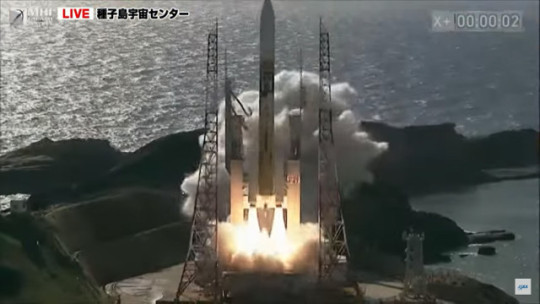
A few hours ago, the Japanese XRISM space telescope and the SLIM Moon lander were launched from the Tanegashima space center atop an H-IIA rocket. After just over 14 minutes, XRISM separated from the rocket's last stage and after about 48 minutes, SLIM did the same. XRISM will reach low Earth orbit, where it will position at an altitude of approximately 550 kilometers. SLIM started a much longer journey.
0 notes
Text


TOKYO, Sept 7 (Reuters) - Japan launched its lunar exploration spacecraft on Thursday aboard a homegrown H-IIA rocket, hoping to become the world's fifth country to land on the moon early next year.
Japan Aerospace Exploration Agency (JAXA) said the rocket took off from Tanegashima Space Center in southern Japan as planned and successfully released the Smart Lander for Investigating Moon (SLIM).
Unfavourable weather led to three postponements in a week last month.
Dubbed the "moon sniper," Japan aims to land SLIM within 100 metres of its target site on the lunar surface.
The $100-million mission is expected to start the landing by February after a long, fuel-efficient approach trajectory.
"The big objective of SLIM is to prove the high-accuracy landing ... to achieve 'landing where we want' on the lunar surface, rather than 'landing where we can'," JAXA President Hiroshi Yamakawa told a news conference.

The launch comes two weeks after India became the fourth nation to successfully land a spacecraft on the moon with its Chandrayaan-3 mission to the unexplored lunar south pole.
Around the same time, Russia's Luna-25 lander crashed while approaching the moon.
Two earlier lunar landing attempts by Japan failed in the last year.
JAXA lost contact with the OMOTENASHI lander and scrubbed an attempted landing in November.
The Hakuto-R Mission 1 lander, made by Japanese startup ispace (9348.T), crashed in April as it attempted to descend to the lunar surface.
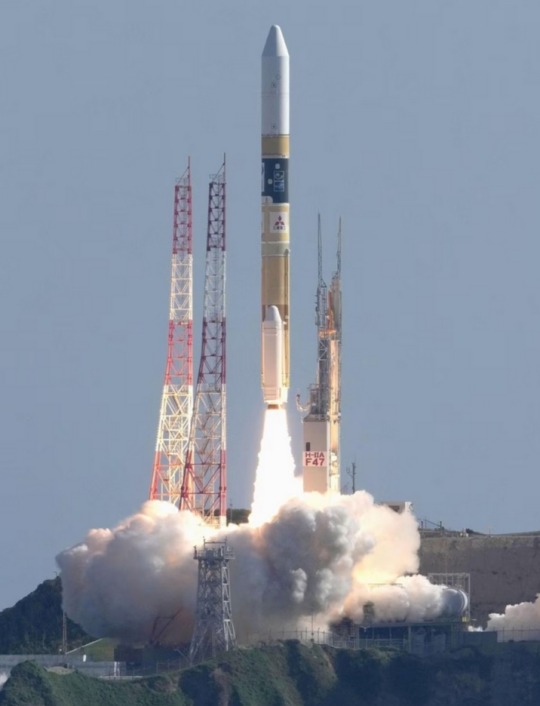
SLIM is set to touch down on the near side of the moon close to Mare Nectaris, a lunar sea that, viewed from Earth, appears as a dark spot.
Its primary goal is to test advanced optical and image processing technology.
After landing, the craft aims to analyse the composition of olivine rocks near the sites in search of clues about the origin of the moon. No lunar rover is loaded on SLIM.
Thursday's H-IIA rocket also carried the X-Ray Imaging and Spectroscopy Mission (XRISM) satellite, a joint project of JAXA, NASA and the European Space Agency.
The satellite aims to observe plasma winds flowing through the universe that scientists see as key to helping understand the evolution of stars and galaxies.

Mitsubishi Heavy Industries (7011.T) manufactured the rocket and operated the launch, which marked the 47th H-IIA rocket Japan has launched since 2001, bringing the vehicle's success rate close to 98%.
JAXA had suspended the launch of H-IIA carrying SLIM for several months while it investigated the failure of its new medium-lift H3 rocket during its debut in March.
Japan's space missions have faced other recent setbacks, with the launch failure of the Epsilon small rocket in October 2022, followed by an engine explosion during a test in July.
The country aims to send an astronaut to the moon's surface in the latter half of the 2020s as part of NASA's Artemis programme.
https://www.reuters.com/technology/space/japan-launches-rocket-carrying-moon-lander-slim-after-three-delays-2023-09-06/
youtube
Japan launches 'Moon Sniper' mission | AFP
7 September 2023
Japan's "Moon Sniper" mission blasted off Thursday as the country's space programme looks to bounce back from a string of recent mishaps, weeks after India's historic lunar triumph.
#H-IIA rocket#Japan#lunar exploration spacecraft#SLIM#moon sniper#Japan Aerospace Exploration Agency (JAXA)#Tanegashima Space Center#Smart Lander for Investigating Moon#Hiroshi Yamakawa#Hakuto-R Mission 1 lander#ispace#Mare Nectaris#X-Ray Imaging and Spectroscopy Mission (XRISM) satellite#JAXA#NASA#European Space Agency#Mitsubishi Heavy Industries#Artemis#space#space rocket#Youtube#Chandrayaan-3 mission#Luna-25 lander#India#Russia#moon#moon landing
22 notes
·
View notes
Text
NASA/JAXA XRISM Mission Reveals Its First Look at X-ray Cosmos
The Japan-led XRISM (X-ray Imaging and Spectroscopy Mission) observatory has released a first look at the unprecedented data it will collect when science operations begin later this year. The satellite’s science team released a snapshot of a cluster of hundreds of galaxies and a spectrum of stellar wreckage in a neighboring galaxy, which gives scientists […]
from NASA https://ift.tt/wyTGoKv
0 notes
Text
Japan will make moon-exploration history in the middle of next month, if all goes to plan.
The Japan Aerospace Exploration Agency (JAXA) announced today (Dec. 5) that it's targeting Jan. 19 for the lunar landing of its robotic SLIM ("Smart Lander for Investigating Moon") spacecraft.
The newly revealed plan calls for SLIM to begin its descent toward the moon on Jan. 19 around 10 a.m. EST (1500 GMT; 12 a.m. on Jan. 20 Japanese Standard Time). Touchdown — which would mark the first-ever soft lunar landing for a Japanese spacecraft — is scheduled to occur about 20 minutes later.
The 8.8-foot-long (2.7 meters) SLIM probe launched atop a Japanese H-2A rocket along with an X-ray space telescope called XRISM on Sept. 6. XRISM deployed into low Earth orbit, but SLIM began making its circuitous, fuel-efficient way to the moon.
If all goes smoothly, SLIM will enter lunar orbit on Christmas Day, then spend nearly a month prepping for its technology-demonstrating touchdown attempt. Success would make Japan just the fifth nation to put a probe down on the moon, after the Soviet Union, the United States, China and India. This landing could also open doors for even more ambitious exploration feats down the road.
Conitnue Reading.
62 notes
·
View notes
Text
Japanese X-Ray Satellite to Probe Universe's Largest Structures
A revolutionary satellite is preparing to take to the skies, viewing the hidden parts of cosmos in a new light to reveal stellar explosions and powerful jets streaming from supermassive black holes.
First Full-Color Images From Webb Space Telescope
XRISM (X-ray Imaging and Spectroscopy Mission), a joint mission between the Japan Aerospace Exploration Agency (JAXA) and NASA, is designed to…
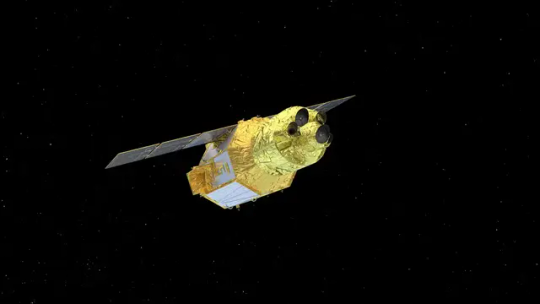
View On WordPress
#European Southern Observatory#Explorers Program#Gizmodo#In spaceflight#Internet#JAXA#Mihoko Yukita#NASA#Ray#Richard Kelley#Smart Lander for Investigating Moon#Space telescopes#Supermassive black hole#Technology#X-ray astronomy satellite#X-Ray Imaging and Spectroscopy Mission#X-ray telescopes
3 notes
·
View notes
Text
Erin Kara named Edgerton Award winner
New Post has been published on https://sunalei.org/news/erin-kara-named-edgerton-award-winner/
Erin Kara named Edgerton Award winner

Class of 1958 Career Development Assistant Professor Erin Kara of the Department of Physics has been named as the recipient of the 2023-24 Harold E. Edgerton Faculty Achievement Award.
Established in 1982, the award is a tribute to the late Institute Professor Emeritus Harold E. Edgerton for his support for younger faculty members. This award recognizes exceptional distinction in teaching, research, and service.
Professor Kara is an observational astrophysicist who is a faculty member in the Department of Physics and a member of the MIT Kavli Institute for Astrophysics and Space Research (MKI). She uses high-energy transients and time-variable phenomena to understand the physics behind how black holes grow and how they affect their environments.
Kara has advanced a new technique called X-ray reverberation mapping, which allows astronomers to map the gas falling onto black holes and measure the effects of strongly curved spacetime close to the event horizon. She also works on a variety of transient phenomena, such as tidal disruption events and galactic black hole outbursts.
She is a NASA Participating Scientist for the XRISM Observatory, a joint JAXA/NASA X-ray spectroscopy mission that just launched this past September, and is a NASA Participating Scientist for the ULTRASAT Mission, an ultraviolet all-sky time domain mission, set to launch in 2027. She is also working to develop and launch the next generation of NASA missions, as deputy principal investigator of the AXIS Probe Mission.
“I am delighted for Erin,” says Claude Canizares, the Bruno Rossi Professor of Physics. “She is an exemplary Edgerton awardee. As one of the leading observational astrophysicists of her generation, she has made major advances in our understanding of black holes and their environments. She also plays a leadership role in the design of new space missions, is a passionate and effective teacher, and a thoughtful mentor of graduate students and postdocs.”
Adds Kavli Director Rob Simcoe, “Erin is one of a very rare breed of experimental astrophysicists who have the interest and stamina not only to use observatories built by colleagues before her, but also to dive into a leadership role planning and executing new spaceflight missions that will shape the future of her field.”
The committee also recognized Kara’s work to create “a stimulating and productive multigenerational research group. Her mentorship is thoughtful and intentional, guiding and supporting each student or postdoc while giving them the freedom to grow and become self-reliant.”
During the nomination process, students praised Kara’s teaching skills, enthusiasm, organization, friendly demeanor, and knowledge of the material.
“Erin is the best faculty mentor I have ever had,” says one of her students. “She is supportive, engaged, and able to provide detailed input on projects when needed, but also gives the right amount of freedom to her students/postdocs to aid in their development. Working with Erin has been one of the best parts of my time at MIT.”
Kara received a BA in physics from Barnard College, and an MPhil in physics and a PhD in astronomy from the Institute of Astronomy at Cambridge University. She subsequently served as Hubble Postdoctoral Fellow and then Neil Gehrels Prize Postdoctoral Fellow at the University of Maryland and NASA’s Goddard Space Flight Center. She joined the MIT faculty in 2019.
Her recognitions include the American Astronomical Society‘s Newton Lacy Pierce Prize, for “outstanding achievement, over the past five years, in observational astronomical research,” and the Rossi Prize from the High-Energy Astrophysics Division of the AAS (shared).
The award committee lauded Kara’s service in the field and at MIT, including her participation with the Physics Graduate Admissions Committee, the Pappalardo Postdoctoral Fellowship Committee, and the MKI Anti-Racism Task Force. Professor Kara also participates in dinners and meet-and-greets invited by student groups, such as Undergraduate Women in Physics, Graduate Women in Physics, and the Society of Physics Students.
Her participation in public outreach programs includes her talks “Black Hole Echoes and the Music of the Cosmos” at both the Concord Conservatory of Music and an event with MIT School of Science alumni, and “What’s for dinner? How black holes eat nearby stars” for the MIT Summer Research Program.
“There is nothing more gratifying than being recognized by your peers, and I am so appreciative and touched that my colleagues in physics even thought to nominate me for this award,” says Kara. “I also want to express my gratitude to my awesome research group. They are what makes this job so fun and so rewarding, and I know I wouldn’t be in this position without their hard work, great attitudes, and unwavering curiosity.”
0 notes
Text
Erin Kara named Edgerton Award winner
New Post has been published on https://thedigitalinsider.com/erin-kara-named-edgerton-award-winner/
Erin Kara named Edgerton Award winner
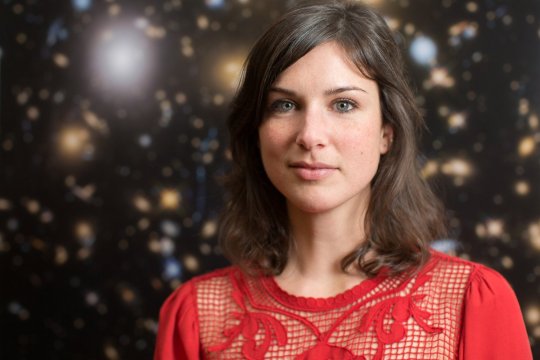

Class of 1958 Career Development Assistant Professor Erin Kara of the Department of Physics has been named as the recipient of the 2023-24 Harold E. Edgerton Faculty Achievement Award.
Established in 1982, the award is a tribute to the late Institute Professor Emeritus Harold E. Edgerton for his support for younger faculty members. This award recognizes exceptional distinction in teaching, research, and service.
Professor Kara is an observational astrophysicist who is a faculty member in the Department of Physics and a member of the MIT Kavli Institute for Astrophysics and Space Research (MKI). She uses high-energy transients and time-variable phenomena to understand the physics behind how black holes grow and how they affect their environments.
Kara has advanced a new technique called X-ray reverberation mapping, which allows astronomers to map the gas falling onto black holes and measure the effects of strongly curved spacetime close to the event horizon. She also works on a variety of transient phenomena, such as tidal disruption events and galactic black hole outbursts.
She is a NASA Participating Scientist for the XRISM Observatory, a joint JAXA/NASA X-ray spectroscopy mission that just launched this past September, and is a NASA Participating Scientist for the ULTRASAT Mission, an ultraviolet all-sky time domain mission, set to launch in 2027. She is also working to develop and launch the next generation of NASA missions, as deputy principal investigator of the AXIS Probe Mission.
“I am delighted for Erin,” says Claude Canizares, the Bruno Rossi Professor of Physics. “She is an exemplary Edgerton awardee. As one of the leading observational astrophysicists of her generation, she has made major advances in our understanding of black holes and their environments. She also plays a leadership role in the design of new space missions, is a passionate and effective teacher, and a thoughtful mentor of graduate students and postdocs.”
Adds Kavli Director Rob Simcoe, “Erin is one of a very rare breed of experimental astrophysicists who have the interest and stamina not only to use observatories built by colleagues before her, but also to dive into a leadership role planning and executing new spaceflight missions that will shape the future of her field.”
The committee also recognized Kara’s work to create “a stimulating and productive multigenerational research group. Her mentorship is thoughtful and intentional, guiding and supporting each student or postdoc while giving them the freedom to grow and become self-reliant.”
During the nomination process, students praised Kara’s teaching skills, enthusiasm, organization, friendly demeanor, and knowledge of the material.
“Erin is the best faculty mentor I have ever had,” says one of her students. “She is supportive, engaged, and able to provide detailed input on projects when needed, but also gives the right amount of freedom to her students/postdocs to aid in their development. Working with Erin has been one of the best parts of my time at MIT.”
Kara received a BA in physics from Barnard College, and an MPhil in physics and a PhD in astronomy from the Institute of Astronomy at Cambridge University. She subsequently served as Hubble Postdoctoral Fellow and then Neil Gehrels Prize Postdoctoral Fellow at the University of Maryland and NASA’s Goddard Space Flight Center. She joined the MIT faculty in 2019.
Her recognitions include the American Astronomical Society‘s Newton Lacy Pierce Prize, for “outstanding achievement, over the past five years, in observational astronomical research,” and the Rossi Prize from the High-Energy Astrophysics Division of the AAS (shared).
The award committee lauded Kara’s service in the field and at MIT, including her participation with the Physics Graduate Admissions Committee, the Pappalardo Postdoctoral Fellowship Committee, and the MKI Anti-Racism Task Force. Professor Kara also participates in dinners and meet-and-greets invited by student groups, such as Undergraduate Women in Physics, Graduate Women in Physics, and the Society of Physics Students.
Her participation in public outreach programs includes her talks “Black Hole Echoes and the Music of the Cosmos” at both the Concord Conservatory of Music and an event with MIT School of Science alumni, and “What’s for dinner? How black holes eat nearby stars” for the MIT Summer Research Program.
“There is nothing more gratifying than being recognized by your peers, and I am so appreciative and touched that my colleagues in physics even thought to nominate me for this award,” says Kara. “I also want to express my gratitude to my awesome research group. They are what makes this job so fun and so rewarding, and I know I wouldn’t be in this position without their hard work, great attitudes, and unwavering curiosity.”
#2023#Admissions#Astronomy#Astrophysics#Awards#honors and fellowships#black hole#Black holes#career#career development#claude#college#cosmos#curiosity#Design#development#disruption#Edgerton#effects#energy#Events#experimental#express#Faculty#flight#Future#gas#Giving#Horizon#how
0 notes
Photo
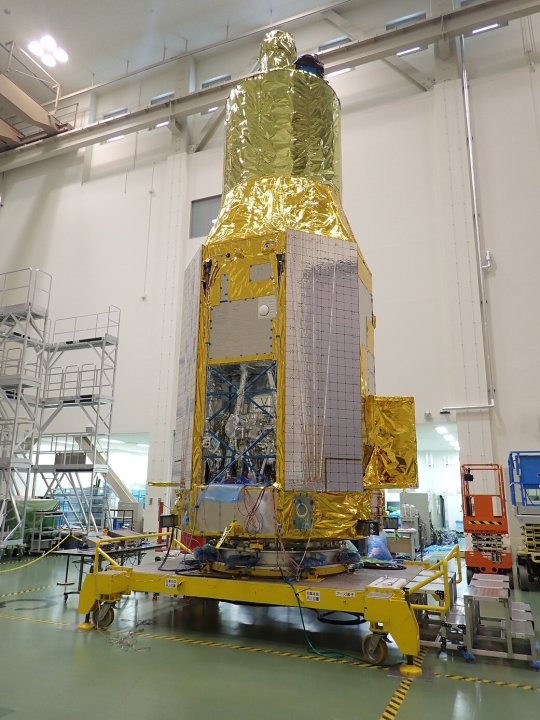
New collaborative X-ray observatory stands tall as testing begins The X-ray Imaging and Spectroscopy Mission will greatly expand our knowledge of the high-energy universe, and recently passed two key milestones on its path to observing the cosmos. Nicknamed XRISM (pronounced "crism"), the mission is a collaboration between the Japan Aerospace Exploration Agency (JAXA) and NASA, with participation by ESA (the European Space Agency), to investigate the X-ray universe using high-resolution imaging and spectroscopy. "In May, the spacecraft components—including its two instruments, named Resolve and Xtend—were mechanically and electrically integrated onto the observatory for the first time," said Project Manager Lillian Reichenthal at NASA's Goddard Space Flight Center in Greenbelt, Maryland. "This was a significant milestone in the development of the spacecraft for JAXA." Having all of the systems installed initiates a new round of spacecraft testing to ensure everything works well together. Engineers integrate and test the equipment at different stages—first individual components, then assembled systems and instruments, and finally the full observatory. These tests subject the spacecraft and instruments to the conditions expected during launch and space operations. In another milestone, testing and calibration of two identical, Goddard-built X-ray Mirror Assemblies (XMAs) was completed, and the mirrors were shipped to Japan in late May and early June. The XMAs underwent separate environmental testing and will receive their final optical alignment before being installed on each instrument in the fall. The Resolve instrument will precisely measure low-energy X-rays to extract information about the physical state and motion of ionized gases associated with supernova remnants, galaxy clusters, and outflows streaming from supermassive black holes in active galaxies. The Xtend instrument, detecting X-rays of similar energy, will produce images with a field of view about 150 times larger than Resolve, extending XRISM's cosmic grasp. "The science from XRISM will be extraordinary," said Goddard's Brian Williams, the NASA project scientist for the mission. "The Resolve instrument promises to open a new window on the high-energy universe." Resolve's detector system was also developed at Goddard. XRISM is expected to launch in 2023 on a JAXA HII-A rocket from Japan's Tanegashima Space Center.
9 notes
·
View notes
Text
MHI Contributes to Successful Acquisition of First Observation Images by JAXA's "XRISM" X-ray Imaging and Spectroscopy Mission Satellite
http://dlvr.it/T2WQkb
0 notes
Text

Poche ore fa fa il telescopio spaziale giapponese XRISM e il lander lunare SLIM sono stati lanciati dal centro spaziale di Tanegashima su un razzo vettore H-IIA. Dopo poco più di 14 minuti XRISM si è regolarmente separato dall'ultimo stadio del razzo e dopo circa 48 minuti lo stesso è avvenuto per SLIM. XRISM raggiungerà l'orbita terrestre bassa, dove si posizionerà ad un'altitudine di circa 550 chilometri. SLIM ha iniziato un viaggio molto più lungo.
0 notes